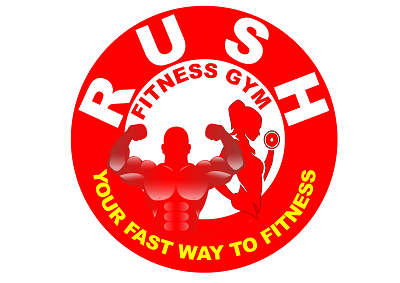3 Healthy Cooking Methods You Shouldn’t Overlook
There are plenty of ways to cook up healthy, flavorful food. Grilling and sautéing are popular go-to cooking styles, but don't forget these tried-and-true alternatives.
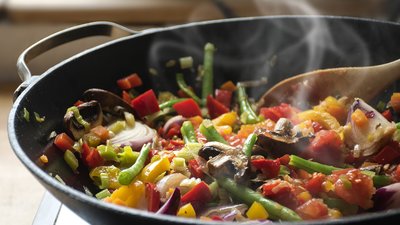
Anybody can toss a burger on the grill or stick a meal in the microwave, but if you want to keep things fresh by coming up with interesting new meals, why not use the full range of meal prep techniques? These three methods will improve the overall nutritional makeup of your diet, and you don't need to be a culinary whiz to pull them off!
Steaming Is Perfect For Delicate Meats
For centuries, cultures around the globe have been cooking food with steam. Suspend almost any meat, vegetable, or fruit in a basket or tray over simmering water and you can prepare foods simply and cleanly.
Unlike boiling, which can leach water-soluble nutrients such as vitamin C and folate from vegetables, steaming helps retain them. When foods are properly steamed, they also retain their moistness, texture, flavor, color, and, in some vegetables, valuable disease-fighting antioxidants.[1,2,3]
Steaming tends to help lean meats like chicken breast and fish retain their moisture instead of being dried out by frying or grilling. And since you don't need oil to steam, you can shave extra calories from your meal.
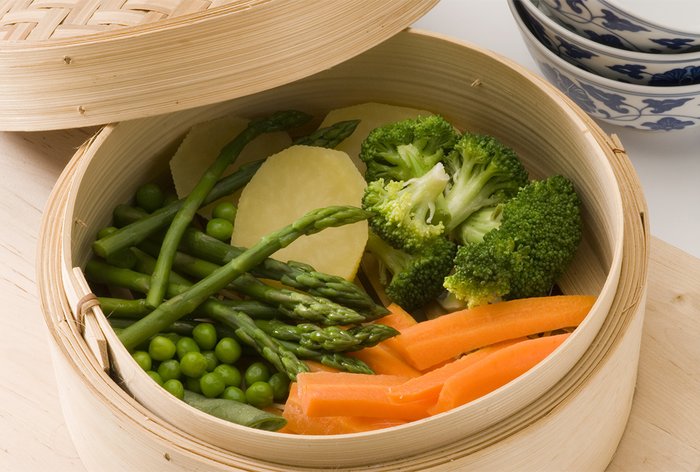
How to steam: To use a steamer, fill the base with a few inches of water, place the steaming tray or trays filled with food on top of the pot, secure the top lid, bring the water to a boil, then reduce heat and let the food steam until fully cooked. Use an instant-read food thermometer to determine when meats are ready.
To ensure each food receives the appropriate amount of heat, place meats and hearty vegetables closest to the steam and the more delicate items, like greens, farther away. Use parchment paper or large greens like Napa cabbage to limit sticking. Don't try to steam too much food at once, and don't allow the food to sit in liquid as it cooks.
Tools of the trade: Inexpensive and durable, old-school bamboo steamers are a nice break from all the metal and silicone found in modern kitchens. With stackable trays, these steamers allow you to cook multiple parts of a meal at the same time, getting food to the table faster and simplifying cleanup. They can be a bit harder to clean, though, and can take on the smell of certain foods. Collapsible or flexible metal or silicone steamers that fit inside pots work, too, as will electric steamers.
What to watch out for: It isn't unusual for vegetables to get over steamed and end up with a mushy texture and no taste, so keep an eye on them as they cook. If you do steam a vegetable for too long, quickly plunge it into a bowl of ice water to interrupt the cooking process. Don't let the steamer run out of fluid or you can ruin it. And remember: Steam is hot! Be careful when opening the steamer trays.
Poaching Keeps Proteins Moist
Like steaming, poaching is also an excellent way to prepare delicate meats such as boneless, skinless poultry breasts or thighs, pork loin, and fish fillets—even some fruits—that are prone to being overcooked when prepared using other methods. Poach a chicken breast, fillet of salmon, or a pear and you'll never again want to dry them out with grilling. Many people claim that a poached egg is the best egg you'll ever eat.
Like steaming, poaching requires no calorie-filled oils, is splatter free, and delivers a wonderful extra benefit: the poaching liquid itself. By adding soup stock, wine, beer, cider, coconut milk, or tomato sauce to the poaching liquid, you can create delicious bases to use in other recipes. Add onions, celery, lemon slices, curry paste, ginger, spices, and herbs to the liquid for extra flavor.
Another benefit of poaching is that it doesn't produce the advanced glycation end products (AGEs) that can come with searing meats at high temperatures. AGEs are thought to contribute to the inflammation in the body associated with maladies like heart disease and cancer.[4]
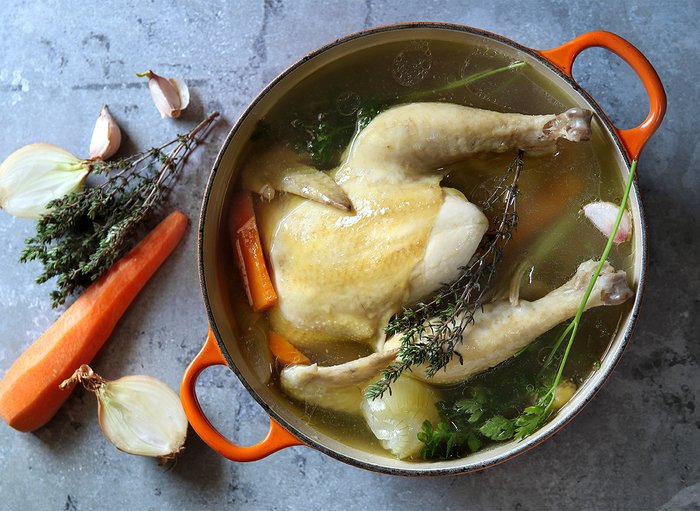
How to poach: Place your food in a pot large enough for it to fit in the pan in one layer. Add liquid to completely cover the food by about one inch. Bring the liquid to a low simmer so that only an occasional bubble breaks the surface. Partly cover the pot and continue poaching until your meat is cooked through, periodically skimming off any foam that accumulates on the top of the liquid.
A four-pound whole chicken takes about 45 minutes to poach and can provide you with a week's worth of meat. Chicken breasts take about 15 minutes to poach, while a skinless salmon fillet can take about 8 minutes.
Tools of the trade: Enameled cast iron or stainless steel pots work great for poaching. The amount of food you want to poach determines the size of the pot. For best results, use a pot that limits the amount of room for extra liquid. Purchase long, slender pans for poaching fish.
What to watch out for: Unlike when you steam, never bring poaching liquid to a boil. This will dissolve fats into the liquid and give the food a greasy quality. As with steaming, be careful not to overcook the food.
Stir-Fry For Crisp Veggies
Stir-frying involves cooking meats and vegetables at a very high heat for a very short time. Short, rapid cooking reduces the time from stove to plate and, because you only use one pan, there is less cleanup. Stir-frying can help retain more nutrients, as well as flavor, texture, and color.
Stir-frying is a great way to bring more vegetables into your diet, since most recipes call for generous amount of vegetables, from carrots and mushrooms to water chestnuts, bean sprouts, broccoli, and bok choy.
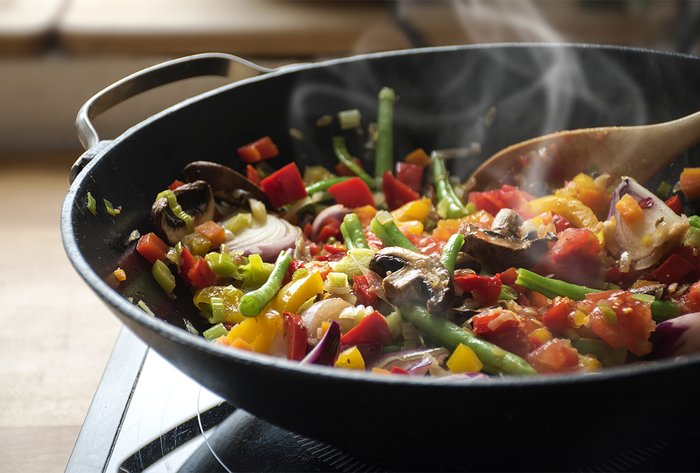
How to stir-fry: Ideally, use a round-bottomed wok pan designed to quickly brown the food in the belly of the pan, then move it up the sloping sides of the pan to cook more slowly.
Things happen quickly down in the belly, so make sure you have all the necessary ingredients cut and ready to go ahead of time. Slice your vegetables and meats into small, uniform pieces so they cook quickly and in the same amount of time.
Use only quick-cooking proteins including chicken breast, steak, shrimp, salmon, pork tenderloin, or tofu. Avoid tough cuts like pork shoulder that benefit from long, slow cooking. Also avoid delicate fish such as sole or flounder.
Preheat your wok or skillet over medium-high heat to get it very hot before adding the oil. Choose oils that have a high smoke point such as avocado, grapeseed, canola, rice bran, peanut, or safflower. Add oil to the wok, making sure to coat the slopes of the pan. Don't use too much oil—just enough to form a thin film on the pan.
Begin by cooking your meat. No more than a pound of raw meat should be placed in the pan at a time. Before tossing it around, let the meat or tofu sit in the pan undisturbed for a few moments so it can brown for better flavor. Once you've fully cooked the meat, remove it from pan and set aside.
To cook your vegetables, start with denser vegetables like carrots, zucchini, or asparagus. Once they're cooked, push them up the side of the wok and add more delicate ingredients such as leafy greens, peas, and even fruits like cubed mango.
Constantly stir and flip the vegetables to prevent them from burning. Once the vegetables are just tender-crisp, return your protein source along with any seasonings or sauces and cook for roughly another minute to blend the flavors.
Tools of the trade: The size of the pan you'll need depends on the number of people you're feeding. A good, middle-of-the-road choice is a 14-inch-wide wok with a depth of at least 4 inches. This size prevents oil from splattering and allows for plenty of food to be cooked at the same time.
An inexpensive carbon steel wok with a wooden handle will get the job done. Over time and with careful cleaning, a steel wok can develop a natural non-stick surface that reduces the amount of oil needed to prepare a meal. A flat-bottomed wok can sit directly on a stovetop burner. You need an adapter ring to use a traditional round-bottomed wok.
You can also stir-fry in a skillet, but make sure to use one that has high sides so that the food and the oil stays inside the pan.
What to watch out for: Many people test the temperature of the wok by sprinkling a few drops of water into it. When the water droplets vaporize on impact, it's time to add your oil. Just be careful not to mix more than a few drops of water in hot oil because it can cause a reaction that sends droplets of hot oil in all directions. Be careful to pat dry your vegetables before you add them to the pan to avoid this.
Source: Bodybuilding.com
Don't forget to share and like this post!
How Much Water Should You Drink Per Day?
The body is about 60% water, give or take.
You are constantly losing water from your body, primarily via urine and sweat. To prevent dehydration, you need to drink adequate amounts of water.
There are many different opinions on how much water you should be drinking every day.
Health authorities commonly recommend eight 8-ounce glasses, which equals about 2 liters, or half a gallon. This is called the 8×8 rule and is very easy to remember.
However, some health gurus believe that you need to sip on water constantly throughout the day, even when you’re not thirsty.
As with most things, this depends on the individual. Many factors (both internal and external) ultimately affect your need for water.
This article takes a look at some water intake studies to separate fact from fiction and explains how to easily match water intake to your individual needs.
Does Water Intake Affect Energy Levels and Brain Function?

Many people claim that if you don’t stay hydrated throughout the day, your energy levels and brain function start to suffer.
And there are plenty of studies to support this.
One study in women showed that a fluid loss of 1.36% after exercise impaired mood and concentration and increased the frequency of headaches (1).
Other studies show that mild dehydration (1–3% of body weight) caused by exercise or heat can harm many other aspects of brain function (2, 3, 4).
Keep in mind that just 1% of body weight is a fairly significant amount. This happens primarily when you’re sweating a lot.
Mild dehydration can also negatively affect physical performance, leading to reduced endurance (5, 6, 7).
SUMMARY
Mild dehydration caused by exercise or heat can have negative effects on both your physical and mental performance.
Does Drinking a Lot of Water Help You Lose Weight?
There are many claims that increased water intake may reduce body weight by increasing your metabolism and reducing your appetite.
According to two studies, drinking 17 ounces (500 ml) of water can temporarily boost metabolism by 24–30% (8).
The image below shows this effect. The top line shows how 17 ounces (500 ml) of water increased metabolism. Notice how this effect decreases before the 90-minute mark (9):

The researchers estimated that drinking 68 ounces (2 liters) in one day increased energy expenditure by about 96 calories per day.
Additionally, it may be beneficial to drink cold water because your body will need to expend more calories to heat the water to body temperature.
Drinking water about a half hour before meals can also reduce the number of calories you end up consuming, especially in older individuals (10, 11).
One study showed that dieters who drank 17 ounces (500 ml) of water before each meal lost 44% more weight over 12 weeks, compared to those who didn’t (12).
Overall, it seems that drinking adequate amounts of water, particularly before meals, may have a significant weight loss benefit, especially when combined with a healthy diet.
What’s more, adequate water intake has a number of other health benefits.
SUMMARY
Drinking water can cause mild, temporary increases in metabolism, and drinking it about a half hour before each meal can make you automatically eat fewer calories. Both of these effects contribute to weight loss.
Does More Water Help Prevent Health Problems?
Several health problems supposedly respond well to increased water intake:
- Constipation: Increasing water intake can help with constipation, a very common problem (13, 14, 15).
- Cancer: Some studies show that those who drink more water have a lower risk of bladder and colorectal cancer, although other studies find no effect (16, 17, 18, 19).
- Kidney stones: Increased water intake may decrease the risk of kidney stones (20, 21).
- Acne and skin hydration: There are a lot of anecdotal reports about how water can help hydrate the skin and reduce acne. So far, no studies have confirmed or refuted this.
SUMMARY
Drinking more water may help with some health problems, such as constipation and kidney stones, but more studies are needed.
Do Other Fluids Count Toward Your Total?
Plain water is not the only drink that contributes to your fluid balance. Other drinks and foods can have a significant effect.
One myth is that caffeinated drinks, such as coffee or tea, don’t help you hydrate because caffeine is a diuretic.
In fact, studies show that the diuretic effect of these beverages is very weak (22).
Most foods are also loaded with water. Meat, fish, eggs and especially fruits and vegetables all contain significant amounts of water.
For more ideas, check out this article on 19 water-rich foods.
Together, coffee or tea and water-rich foods can help maintain your fluid balance.
SUMMARY
Other beverages can contribute to fluid balance, including coffee and tea. Most foods also contain water.
Maintaining water balance is essential for your survival.
For this reason, your body has a sophisticated system for regulating when and how much you drink.
When your total water content goes below a certain level, thirst kicks in.
This is controlled by mechanisms similar to breathing — you don’t need to consciously think about it.
For the majority of people, there probably isn’t any need to worry about water intake. The thirst instinct is very reliable (23).
There really is no science behind the 8×8 rule. It is completely arbitrary (24).
That said, certain circumstances may call for increased water intake.
The most important one may be during times of increased sweating. This includes exercise and hot weather, especially in a dry climate.
If you’re sweating a lot, make sure to replenish the lost fluid with water. Athletes doing very long, intense exercises may also need to replenish electrolytes along with water.
Your water need also increases during breastfeeding, as well as several disease states like vomiting and diarrhea.
Furthermore, older people may need to consciously watch their water intake because the thirst mechanisms can start to malfunction in old age (25).
SUMMARYMost people don’t need to consciously think about their water intake, as the thirst mechanism in the brain is very effective. However, certain circumstances do call for increased attention to water intake.
At the end of the day, no one can tell you exactly how much water you need. This depends on the individual.
Try experimenting to see what works best for you. Some people may function better with more water than usual, while for others it only results in more frequent trips to the bathroom.
If you want to keep things simple, these guidelines should apply to the majority of people:
- When you’re thirsty, drink.
- When you’re not thirsty anymore, stop.
- During high heat and exercise, make sure to drink enough to compensate for the lost fluids.
- That’s it!
Source: healthline.com
Don't forget to share!
